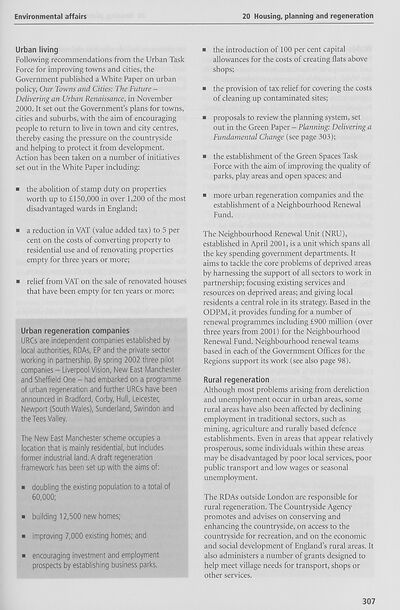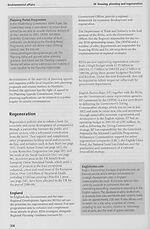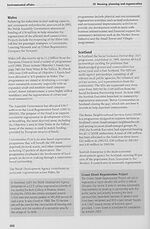Download files
Complete book:
Individual page:
Thumbnail gallery: Grid view | List view

Environmental affairs
20 Housing, planning and regeneration
Urban living
Following recommendations from the Urban Task
Force for improving towns and cities, the
Government published a White Paper on urban
policy, Our Towns and Cities: The Future -
Delivering an Urban Renaissance, in November
2000. It set out the Government’s plans for towns,
cities and suburbs, with the aim of encouraging
people to return to live in town and city centres,
thereby easing the pressure on the countryside
and helping to protect it from development.
Action has been taken on a number of initiatives
set out in the White Paper including:
■ the abolition of stamp duty on properties
worth up to £150,000 in over 1,200 of the most
disadvantaged wards in England;
■ a reduction in VAT (value added tax) to 5 per
cent on the costs of converting property to
residential use and of renovating properties
empty for three years or more;
■ relief from VAT on the sale of renovated houses
that have been empty for ten years or more;
Urban regeneration companies
URCs are independent companies established by
local authorities, RDAs, EP and the private sector
working in partnership. By spring 2002 three pilot
companies - Liverpool Vision, New East Manchester
and Sheffield One - had embarked on a programme
of urban regeneration and further URCs have been
announced in Bradford, Corby, Hull, Leicester,
Newport (South Wales), Sunderland, Swindon and
the Tees Valley.
The New East Manchester scheme occupies a
location that is mainly residential, but includes
former industrial land. A draft regeneration
framework has been set up with the aims of:
■ doubling the existing population to a total of
60,000;
■ building 12,500 new homes;
■ improving 7,000 existing homes; and
■ encouraging investment and employment
prospects by establishing business parks.
■ the introduction of 100 per cent capital
allowances for the costs of creating flats above
shops;
■ the provision of tax relief for covering the costs
of cleaning up contaminated sites;
■ proposals to review the planning system, set
out in the Green Paper - Planning: Delivering a
Fundamental Change (see page 303);
■ the establishment of the Green Spaces Task
Force with the aim of improving the quality of
parks, play areas and open spaces; and
■ more urban regeneration companies and the
establishment of a Neighbourhood Renewal
Fund.
The Neighbourhood Renewal Unit (NRU),
established in April 2001, is a unit which spans all
the key spending government departments. It
aims to tackle the core problems of deprived areas
by harnessing the support of all sectors to work in
partnership; focusing existing services and
resources on deprived areas; and giving local
residents a central role in its strategy. Based in the
ODPM, it provides funding for a number of
renewal programmes including £900 million (over
three years from 2001) for the Neighbourhood
Renewal Fund. Neighbourhood renewal teams
based in each of the Government Offices for the
Regions support its work (see also page 98).
Rural regeneration
Although most problems arising from dereliction
and unemployment occur in urban areas, some
rural areas have also been affected by declining
employment in traditional sectors, such as
mining, agriculture and rurally based defence
establishments. Even in areas that appear relatively
prosperous, some individuals within these areas
may be disadvantaged by poor local services, poor
public transport and low wages or seasonal
unemployment.
The RDAs outside London are responsible for
rural regeneration. The Countryside Agency
promotes and advises on conserving and
enhancing the countryside, on access to the
countryside for recreation, and on the economic
and social development of England’s rural areas. It
also administers a number of grants designed to
help meet village needs for transport, shops or
other services.
307
20 Housing, planning and regeneration
Urban living
Following recommendations from the Urban Task
Force for improving towns and cities, the
Government published a White Paper on urban
policy, Our Towns and Cities: The Future -
Delivering an Urban Renaissance, in November
2000. It set out the Government’s plans for towns,
cities and suburbs, with the aim of encouraging
people to return to live in town and city centres,
thereby easing the pressure on the countryside
and helping to protect it from development.
Action has been taken on a number of initiatives
set out in the White Paper including:
■ the abolition of stamp duty on properties
worth up to £150,000 in over 1,200 of the most
disadvantaged wards in England;
■ a reduction in VAT (value added tax) to 5 per
cent on the costs of converting property to
residential use and of renovating properties
empty for three years or more;
■ relief from VAT on the sale of renovated houses
that have been empty for ten years or more;
Urban regeneration companies
URCs are independent companies established by
local authorities, RDAs, EP and the private sector
working in partnership. By spring 2002 three pilot
companies - Liverpool Vision, New East Manchester
and Sheffield One - had embarked on a programme
of urban regeneration and further URCs have been
announced in Bradford, Corby, Hull, Leicester,
Newport (South Wales), Sunderland, Swindon and
the Tees Valley.
The New East Manchester scheme occupies a
location that is mainly residential, but includes
former industrial land. A draft regeneration
framework has been set up with the aims of:
■ doubling the existing population to a total of
60,000;
■ building 12,500 new homes;
■ improving 7,000 existing homes; and
■ encouraging investment and employment
prospects by establishing business parks.
■ the introduction of 100 per cent capital
allowances for the costs of creating flats above
shops;
■ the provision of tax relief for covering the costs
of cleaning up contaminated sites;
■ proposals to review the planning system, set
out in the Green Paper - Planning: Delivering a
Fundamental Change (see page 303);
■ the establishment of the Green Spaces Task
Force with the aim of improving the quality of
parks, play areas and open spaces; and
■ more urban regeneration companies and the
establishment of a Neighbourhood Renewal
Fund.
The Neighbourhood Renewal Unit (NRU),
established in April 2001, is a unit which spans all
the key spending government departments. It
aims to tackle the core problems of deprived areas
by harnessing the support of all sectors to work in
partnership; focusing existing services and
resources on deprived areas; and giving local
residents a central role in its strategy. Based in the
ODPM, it provides funding for a number of
renewal programmes including £900 million (over
three years from 2001) for the Neighbourhood
Renewal Fund. Neighbourhood renewal teams
based in each of the Government Offices for the
Regions support its work (see also page 98).
Rural regeneration
Although most problems arising from dereliction
and unemployment occur in urban areas, some
rural areas have also been affected by declining
employment in traditional sectors, such as
mining, agriculture and rurally based defence
establishments. Even in areas that appear relatively
prosperous, some individuals within these areas
may be disadvantaged by poor local services, poor
public transport and low wages or seasonal
unemployment.
The RDAs outside London are responsible for
rural regeneration. The Countryside Agency
promotes and advises on conserving and
enhancing the countryside, on access to the
countryside for recreation, and on the economic
and social development of England’s rural areas. It
also administers a number of grants designed to
help meet village needs for transport, shops or
other services.
307
Set display mode to:
![]() Universal Viewer |
Universal Viewer | ![]() Mirador |
Large image | Transcription
Mirador |
Large image | Transcription
The item on this page appears courtesy of Office for National Statistics and may be re-used under the Open Government Licence for Public Sector Information.
| Britain and UK handbooks > UK: The official yearbook of the United Kingdom of Great Britain and Northern Ireland > 2003 > (345) |
|---|
| Permanent URL | https://digital.nls.uk/204927595 |
|---|
| Attribution and copyright: |
|
|---|---|
| Description | Three volumes of 'UK: The official yearbook of the United Kingdom of Great Britain and Northern Ireland', published annually by the Office of National Statistics from 2002-2005. |
|---|---|
| Shelfmark | GII.11 SER |
| Description | Three titles produced by the British Government from 1954-2005 describing 'how Britain worked'. They are: 'Britain: An official handbook' (1954-1998), 'Britain: The official yearbook of the United Kingdom' (1999-2001), and 'UK: The official yearbook of the United Kingdom of Great Britain and Northern Ireland' (2002-2005). These 50 reports provide an overview of Britain's economic, social and cultural affairs, its environment, international relations, and the systems of government. They give an impartial summary of government policies and initiatives, and explain how public services are organised. |
|---|---|
| Additional NLS resources: |
|

